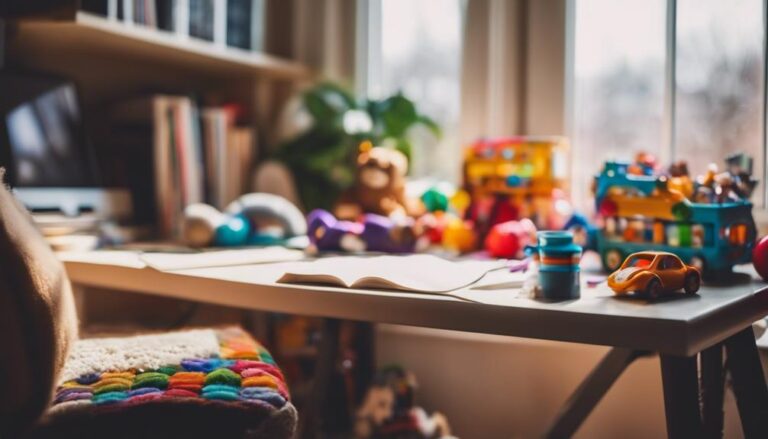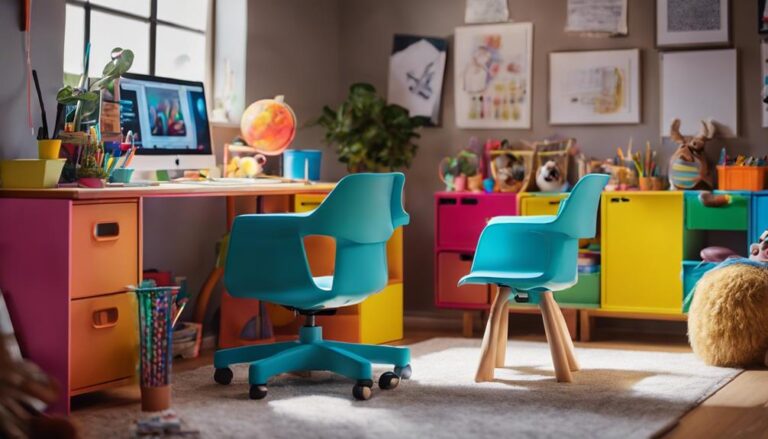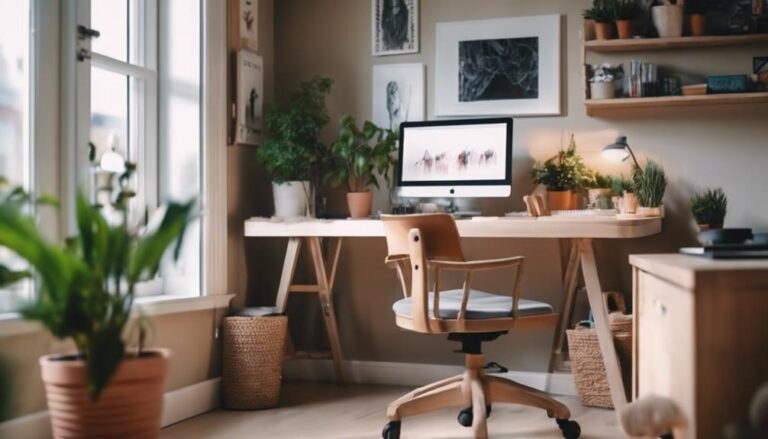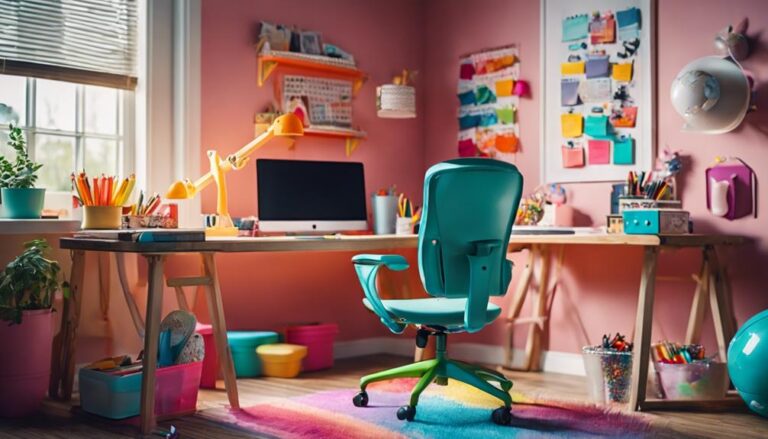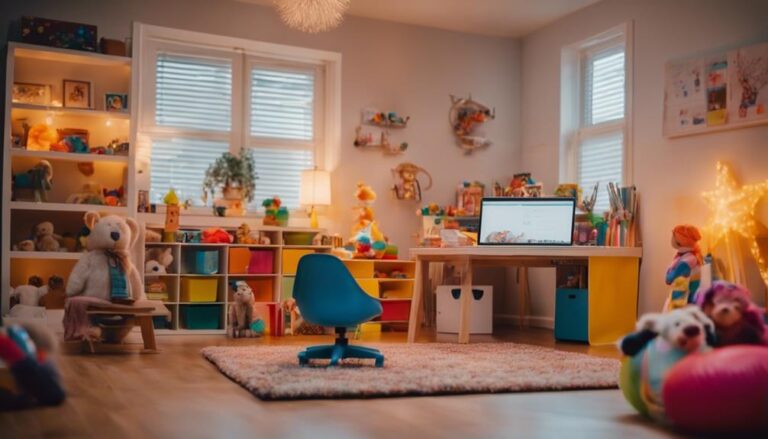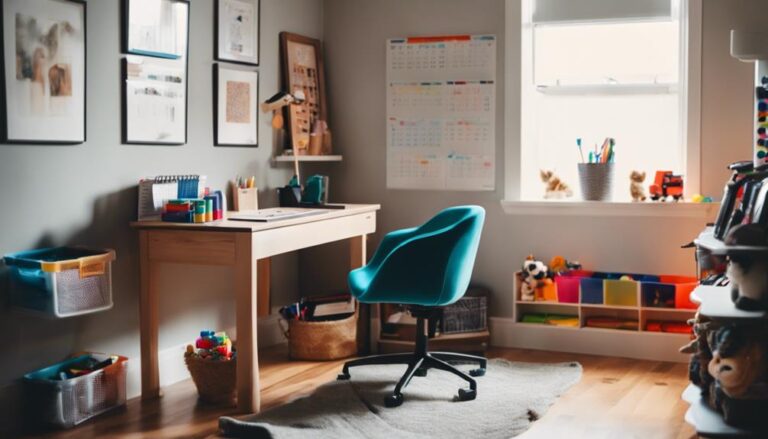I've discovered that creating a kid-safe home office involves a few key strategies. First, I always anchor heavy furniture and conceal cables to prevent accidents. I also use childproof locks on drawers and cabinets to keep dangerous items out of reach. Essential gates are vital for blocking off hazardous areas. I opt for ergonomic furniture to guarantee comfort and good posture. Additionally, setting up a kid-friendly activity area keeps my children entertained and close by. Keeping my workspace organized and secure doesn't just make it safer, it also makes it more functional. There's a bit more to contemplate for the ultimate setup.
Key Takeaways
- Anchor heavy furniture and use childproof outlets to prevent accidents.
- Install childproof locks on cabinets and drawers to restrict access to dangerous items.
- Set up safety gates to block off hazardous areas and prevent falls.
- Use cable organizers to manage cords and eliminate tripping hazards.
- Create a kid-friendly activities area to keep children engaged and supervised.
Designated Workspace
Establishing a designated workspace within your home office is crucial for maintaining productivity and guaranteeing a kid-safe environment. I've found that creating a specific area for work helps me focus and minimizes distractions.
Equally important is setting up a designated play area for children, allowing them to play independently while I work. This setup keeps both areas organized and functional.
Placing my workspace strategically lets me supervise and monitor my child easily. Personalizing my workspace with photos and decorations makes it inviting and comfortable, boosting morale.
Additionally, using child-friendly furniture and incorporating safety measures guarantees a secure environment for both work and play. This balance fosters innovation and efficiency in a kid-safe home office.
Childproof Locks
Securing cabinets and drawers with childproof locks is a critical step in creating a safe home office environment. These locks prevent children from accessing dangerous items, ensuring child safety.
Here's how to effectively implement them:
- Choose the Right Type: Consider magnetic locks, adhesive locks, or sliding locks to match your furniture. Each design offers unique features to suit different needs.
- Easy Installation: Most childproof locks are straightforward to install, making it simple to enhance safety without professional help.
- Durability: Invest in quality locks designed to withstand the curiosity and exploration of young children, providing peace of mind.
Organized Cables
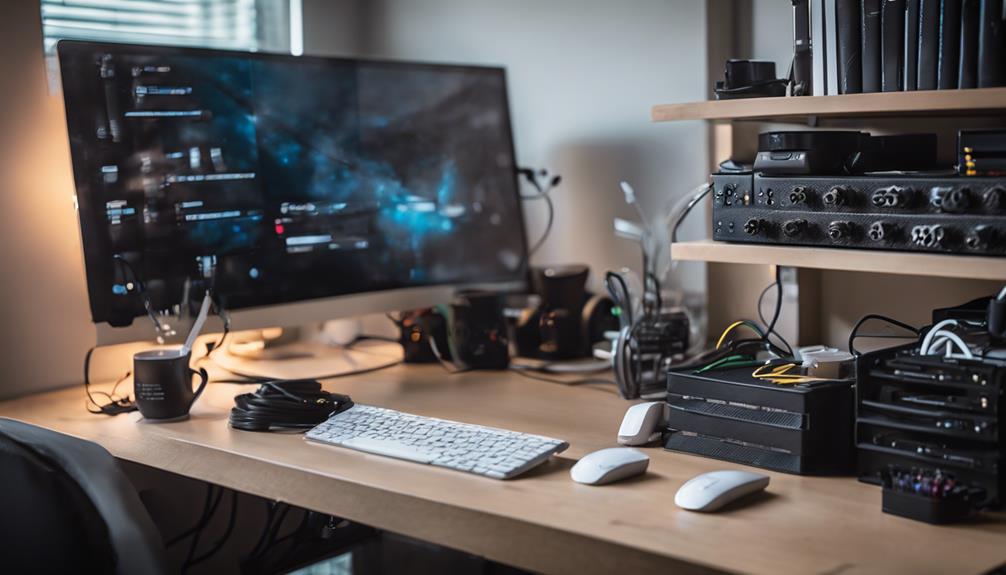
When it comes to organizing cables in a kid-safe home office, I always recommend using cable organizers or clips to keep cords neatly arranged and out of the way. Securing cables along the edges of desks or walls prevents tripping hazards and keeps them out of reach of curious little hands.
Additionally, labeling cords with color-coded tags makes it easy to manage and identify electronic devices in your workspace.
Cable Management Solutions
Effectively managing your cables with tools like clips, sleeves, or zip ties is crucial to keeping your home office safe for kids. Not only does it enhance safety by reducing tripping hazards, but it also prevents curious little hands from pulling on or getting tangled in cords.
Here are three innovative solutions for organized cables:
- Cable Clips: Securely attach cables along baseboards or under desks to keep them out of reach.
- Cable Sleeves: Bundle multiple cords together, creating a streamlined and safer workspace.
- Zip Ties: Use these for a quick, effective way to bind and shorten excess cable length.
Investing in these cable management tools ensures a clutter-free, kid-safe home office setup.
Safety Precautions Tips
Organizing your cables not only creates a safer environment for kids but also enhances the efficiency and tidiness of your home office. Safety tips like securing cables away from children's reach greatly reduce the risk of accidental entanglement or pulling.
Using cable management tools such as cord organizers and cable clips can keep cords tidy and safe. This proactive approach prevents tripping hazards for both adults and children, fostering a clutter-free workspace.
Proper cable organization boosts the overall look and functionality of your home office, ensuring a child-safe environment. By implementing effective cable management solutions, you're not just promoting safety but also innovating your workspace for better productivity and aesthetics.
Secure Equipment
To maintain my home office safe for kids, I start by securely anchoring heavy furniture to the walls to prevent tip-over accidents.
I also use cable management systems to safely conceal cords, minimizing the risk of tripping or entanglement.
These simple yet effective steps guarantee both safety and functionality in my workspace.
Anchor Heavy Furniture
Securing heavy furniture in your home office is essential to preventing tipping accidents that could seriously harm your child. By taking proactive steps to secure furniture, you create a safer environment.
Here are three practical tips to get started:
- Use Furniture Anchors: Attach bookcases, cabinets, and other heavy items to the wall using anchors or straps. This simple measure can greatly reduce tipping risks.
- Regularly Check Anchors: Make sure that all equipment and furniture in your home office remain securely anchored. Regular inspections help maintain safety.
- Choose Sturdy Furniture: Opt for robust, well-balanced furniture that's less likely to tip over in the first place.
Anchoring heavy furniture isn't just practical; it's an important innovation in child safety.
Conceal Cables Safely
After anchoring heavy furniture, it's important to conceal cables safely to prevent tripping hazards and protect your child from electrical dangers.
I use cable management solutions like cord covers and cable clips to hide and secure cords. Concealing cables behind furniture or using cable sleeves helps maintain a tidy and safe workspace.
Keeping electronic devices out of reach or securely mounted further reduces risks. Investing in childproof electrical outlets and surge protectors adds an extra layer of safety.
This approach not only protects curious little fingers but also keeps my office looking sleek and organized. By taking these steps, I create a secure environment that balances functionality with child safety.
Safety Gates
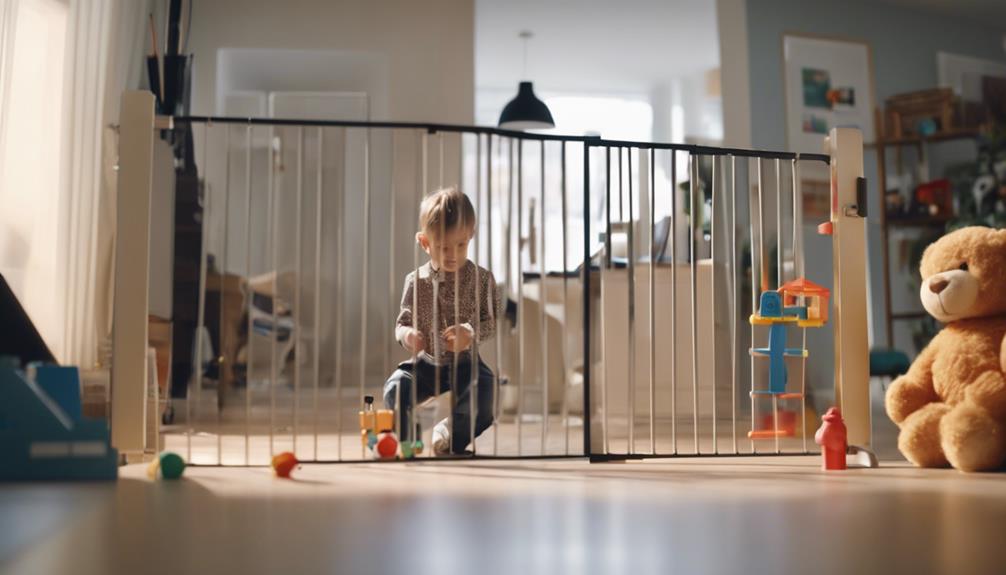
Every parent knows that safety gates are an essential tool for keeping young children away from potentially dangerous areas in the home office. By installing safety gates, we can create a secure environment that allows our children to explore safely while we work.
Here are three key points to keep in mind when choosing the right safety gate:
- Design Options: Choose from pressure-mounted, hardware-mounted, or retractable gates to fit your office layout.
- Placement: Use safety gates to block off staircases, doorways, and other hazardous areas.
- AAP Recommendations: Follow guidelines from the American Academy of Pediatrics to prevent falls and injuries.
With the right safety gate, we can balance productivity and child safety effectively.
Door Locks
Installing childproof door locks is an essential step in creating a kid-safe home office. To prevent children from accessing potentially dangerous areas, make sure to use door locks with child safety features. These locks effectively restrict access to rooms that might've sharp objects or electrical equipment.
It's imperative to install them at a height out of reach for young children, ensuring they can't open doors unsupervised. For added security, consider using door knob covers or latch locks. Regularly check these locks to make sure they're functioning properly, keeping children safely contained within the home office space.
Clear Rules
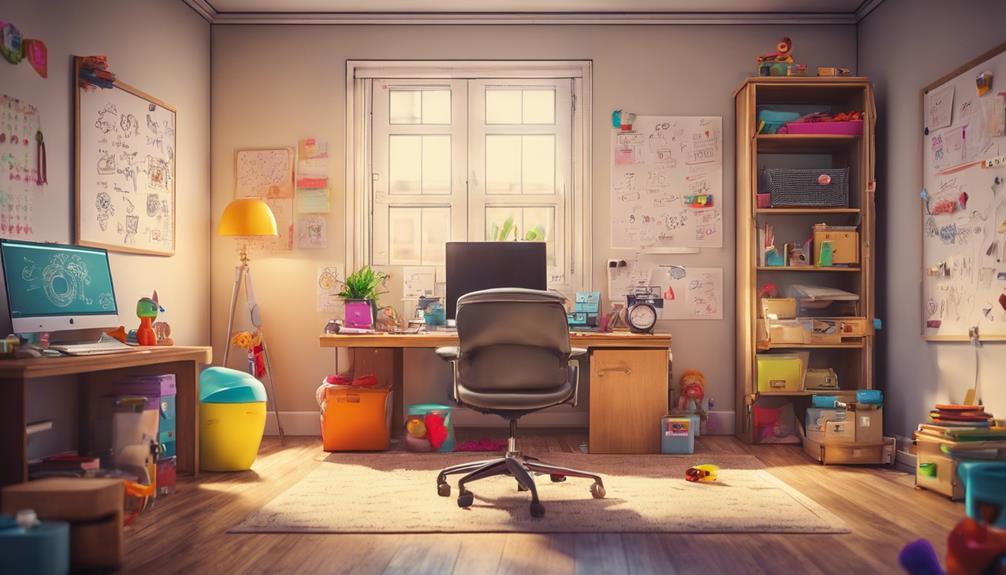
To foster a safe and productive home office environment, it's vital to establish clear rules about what's and isn't allowed. By clearly communicating boundaries and expectations, we can prevent accidents and maintain a productive workspace. Here are three important rules to implement:
- No Entry Without Permission: Kids must ask before entering the office to avoid unexpected disruptions.
- Designated Play Areas: Set specific zones for play, keeping hazardous items out of reach.
- Open Dialogue: Encourage discussions about safety measures and potential hazards.
Enforcing these clear rules consistently helps children understand their importance. Implementing consequences for breaking them reinforces the need for a kid-safe home office. This approach ensures a balanced, innovative workspace that's both safe and productive.
Ergonomic Furniture
When setting up a kid-safe home office, I prioritize ergonomic furniture like adjustable desks and child-safe chairs.
Adjustable desk heights guarantee proper posture, while chairs designed for kids offer the necessary support and comfort.
These choices not only enhance safety but also promote a healthy workspace environment for growing children.
Adjustable Desk Height
One of the smartest investments for a kid-safe home office is an adjustable desk that caters to both adults and children, guaranteeing everyone maintains proper ergonomics. Adjustable desk height is vital for creating a versatile workspace that promotes good posture and reduces the risk of musculoskeletal issues.
Not only does this investment enhance comfort, but it also boosts productivity and overall well-being for all users.
Here are three reasons why adjustable desk height is essential:
- Customization: Easily adjust the desk to fit both adult and child users.
- Ergonomics: Supports proper posture, reducing strain and discomfort.
- Safety: Ensures a comfortable and safe workspace for children in a shared office.
Investing in ergonomic furniture is a step towards a healthier, more productive home office.
Child-Safe Chair Design
Just as an adjustable desk supports everyone's comfort and productivity, choosing the right child-safe chair design is equally important for creating an ergonomic and secure home office. To guarantee both safety and functionality, I focus on several key features for child-safe chair design:
| Feature | Benefit |
|---|---|
| Rounded edges | Prevents injuries from sharp corners |
| Stability | Ensures the chair doesn't tip over easily |
| Adjustable height | Accommodates children of various sizes |
| Non-slip feet | Prevents accidental tipping or sliding |
In addition, chairs made from easy-to-clean materials are essential for maintaining a hygienic workspace. When selecting ergonomic furniture, these factors ensure a safe, adaptable, and clean environment, promoting both productivity and well-being.
Safe Storage
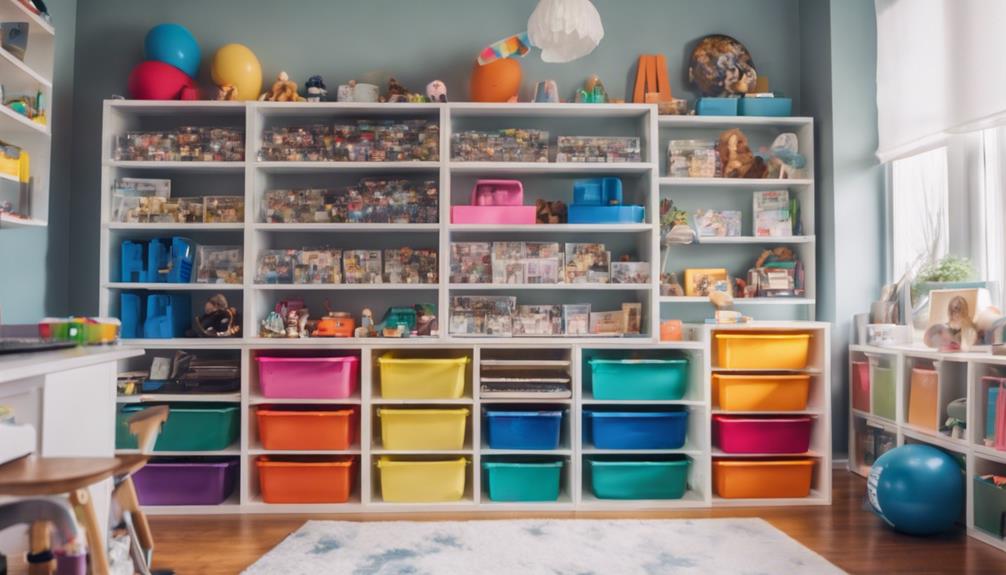
Keeping office supplies safely out of reach is essential, so I use cabinets with childproof locks to prevent any accidents. Safe storage plays a critical role in maintaining a kid-safe home office.
Here are some practical steps I follow:
- Secure Small Items: I store small items like paper clips and pins in secure containers to eliminate choking hazards.
- Heavy Items Management: Heavy items are kept on lower shelves or secured to prevent them from tipping over onto children.
- Safety Latches: Drawers have safety latches installed to keep sharp objects and harmful materials out of reach.
Kid-Friendly Activities
To guarantee my kids are engaged and entertained while I work, I've set up an art station stocked with crayons, markers, and coloring books. This creative outlet keeps their hands busy and minds active.
Interactive educational toys like puzzles and building blocks offer both fun and learning, stimulating their curiosity. I've also created a cozy reading nook filled with a variety of storybooks and educational books that cater to different interests.
By incorporating age-appropriate activities, I make sure my children are engaged and learning. A designated corner with these engaging activities within easy reach allows me to maintain productivity while knowing they're occupied.
Balancing work and parenting becomes much smoother with these practical, innovative solutions.
Frequently Asked Questions
How Do You Childproof an Office?
To childproof an office, I secure furniture with rounded edges, use cabinets for small items, cover electrical outlets with dummy plugs, keep equipment high up, and monitor doors to prevent injuries. Safety innovation is essential.
At What Age Should You Baby Proof Your House?
Coincidentally, I found that baby proofing should start before my baby hit developmental milestones like crawling, around 6 months old. It's important to align safety measures with their growing mobility to establish a secure environment.
How to Childproof Your Home?
To childproof my home, I use safety gates on stairs, cover electrical outlets, and secure heavy furniture. I also install cabinet locks, use outlet covers, and keep harmful substances out of reach. Safety first!
When Child Proofing a Home or Office in Order to Make It Safe, Which Method Should Be Used?
Did you know that safety gates can reduce child injuries by up to 50%? When childproofing a home or office, I always recommend installing safety gates on stairs to prevent dangerous falls and promote a safer environment.
Conclusion
So there you have it—because nothing says 'productive home office' like maneuvering safety gates and childproof locks while dodging flying crayons.
Maybe you'll even get a few moments of uninterrupted work between organizing cables and securing equipment.
And let's not forget the joy of ergonomic furniture that's safe for tiny climbers.
Remember, the key to a kid-safe home office is simple: just turn parenting into a full-time job.
Now, back to conquering that to-do list, right?

